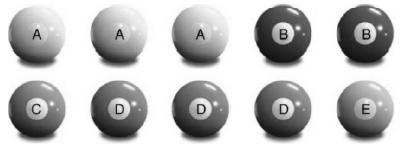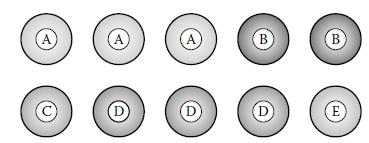Refer to the IEEE Transactions on Information Forensics and Security (March 2013) study of wireless identify theft
Question:
Refer to the IEEE Transactions on Information Forensics and Security (March 2013) study of wireless identify theft using cloned credit or debit cards, Exercise 3.44. A cloning detection method was illustrated using a simple ball drawing game. Consider the group of 10 balls shown below. Of these, 5 represent genuine credit/debit cards and 5 represent clones of one or more of these cards. The 5 letters—A, B, C, D, and E—were used to distinguish among the different genuine cards. (Balls with the same letter represent either the genuine card or a clone of the card.) For this illustration, let X represent the number of genuine balls selected and Y represent the number of B-lettered balls selected when 2 balls are randomly drawn (without replacement) from the 10 balls.

a. Find the bivariate probability distribution, p (x, y).
b. Find the marginal distribution, p1 (x).
c. Find the marginal distribution, p2 (y).
d. Recall that if two balls with the same letter are drawn from the 10 balls, then a cloning attack is detected. Consider a credit card identified by a B-lettered ball. Use your answer to part c to find the probability of a cloning attack for this card.
Data from Exercise 3.44
Wireless identity theft is a technique of stealing an individual’s personal information from radio-frequency-enabled cards (e.g., credit or debit cards). Upon capturing this data, thieves are able to program their own cards to respond in an identical fashion via cloning. A method for detecting cloning attacks in radiofrequency identification (RFID) applications was explored in IEEE Transactions on Information Forensics and Security (March, 2013). The method was illustrated using a simple ball drawing game. Consider a group of 10 balls, 5 representing genuine RFID cards and 5 representing clones of one or more of these cards. A labeling system was used to distinguish among the different genuine cards. Since there are 5 genuine cards, 5 letters—A, B, C, D, and E—were used. Balls labeled with the same letter represent either the genuine card or a clone of the card. Suppose the 10 balls are labeled as follows: 3 A’s, 2 B’s, 1 C, 3 D’s, 1 E. (See figure below.) Note that the singleton C and E balls must represent the genuine cards (i.e., there are no clones of these cards). If two balls of the same letter are drawn (without replacement) from the 10 balls, then a cloning attack is detected. For this example, find the probability of detecting a cloning attack.

Step by Step Answer:

Statistics For Engineering And The Sciences
ISBN: 9781498728850
6th Edition
Authors: William M. Mendenhall, Terry L. Sincich





